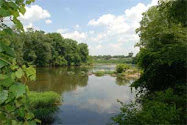 We met fairly early at the Stratford Hall Visitor Center, where we were introduced to our guides. There was a discussion on the types of fossils that have been found, including the favored Megladon teeth and some of the rare finds that have been made. While a ticket to Stratford Hall will allow access to the beach, that access is restricted to a small area. We had received special permission to walk past the ropes and head far up the beach. To provide a more hands on experience the two guides split us into two groups and we heading in opposite directions.
We met fairly early at the Stratford Hall Visitor Center, where we were introduced to our guides. There was a discussion on the types of fossils that have been found, including the favored Megladon teeth and some of the rare finds that have been made. While a ticket to Stratford Hall will allow access to the beach, that access is restricted to a small area. We had received special permission to walk past the ropes and head far up the beach. To provide a more hands on experience the two guides split us into two groups and we heading in opposite directions. |
| Layers of clay with visible fossils |
 |
| Clay layer |
 Armed with waterproof boots, bucket, small shovel and an inexpensive plastic colander I followed our guide Theresa. The weather was perfect, a bit cool but not uncomfortable. We walked along the beach at low tide, Theresa pointing out how to look for sharks teeth, bone, fossilized shells and the like. She pointed out the cliffs (you do not want to walk too closely, a large piece fell while we where there) where you could easily see the stratification. Each layer of clay was from a different time period, sometimes fossils or mammal bones were evident in each layer. She spoke of the different animals the fossils came from. At this point I really wished I had thought to write down everything as my memory is not what it use to be. What looked like large gray rocks and boulders on the beach, were in fact compressed clay. Theresa said the fossils would often be found in the clay.
Armed with waterproof boots, bucket, small shovel and an inexpensive plastic colander I followed our guide Theresa. The weather was perfect, a bit cool but not uncomfortable. We walked along the beach at low tide, Theresa pointing out how to look for sharks teeth, bone, fossilized shells and the like. She pointed out the cliffs (you do not want to walk too closely, a large piece fell while we where there) where you could easily see the stratification. Each layer of clay was from a different time period, sometimes fossils or mammal bones were evident in each layer. She spoke of the different animals the fossils came from. At this point I really wished I had thought to write down everything as my memory is not what it use to be. What looked like large gray rocks and boulders on the beach, were in fact compressed clay. Theresa said the fossils would often be found in the clay. |
| Fallen clay |
 |
| Denise is searching |
 |
| Sharks Teeth |
 |
| Fossilized impressions in clay |
 |
| Rib bone, bone fragment, whale vertebrae |




